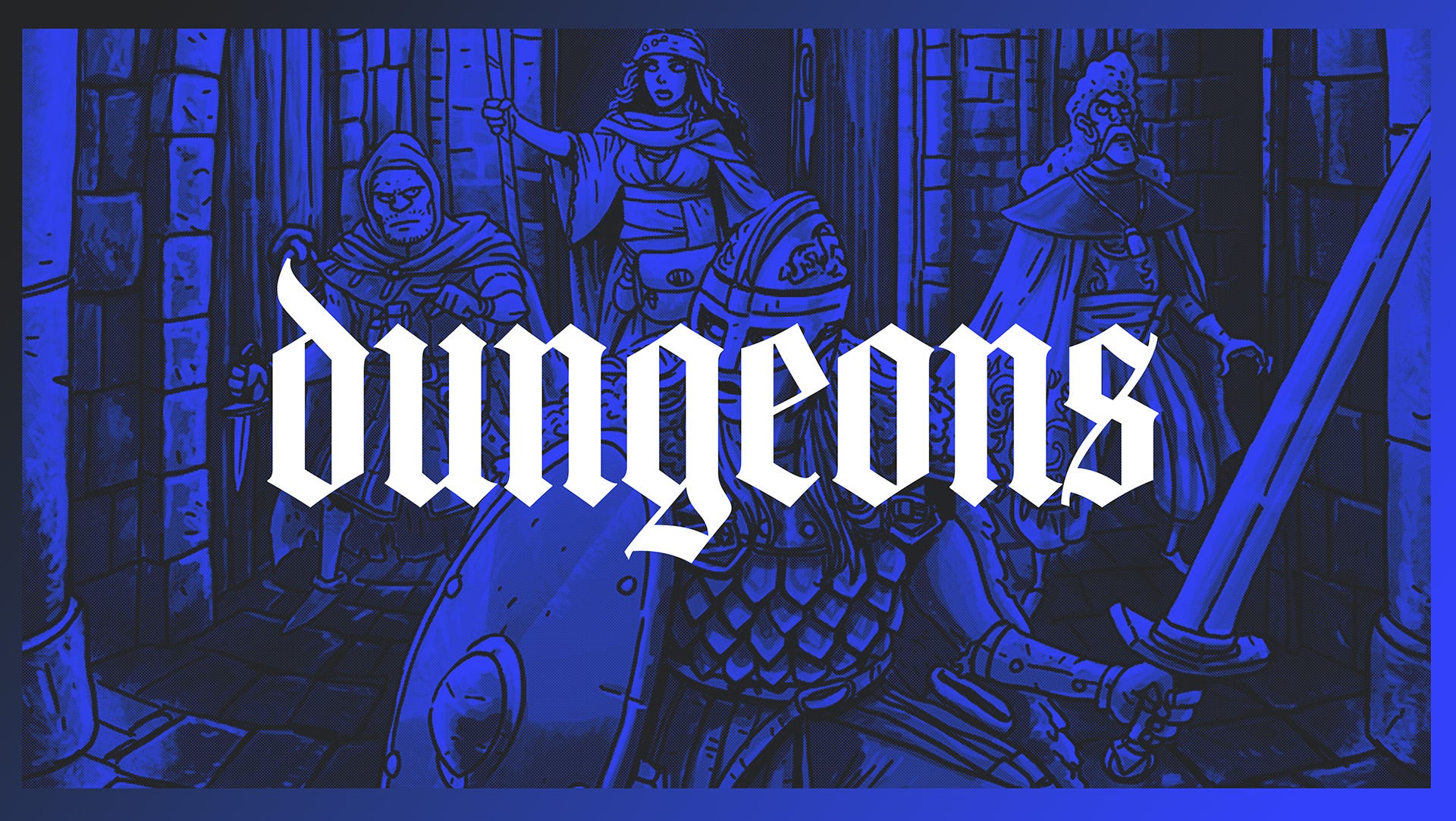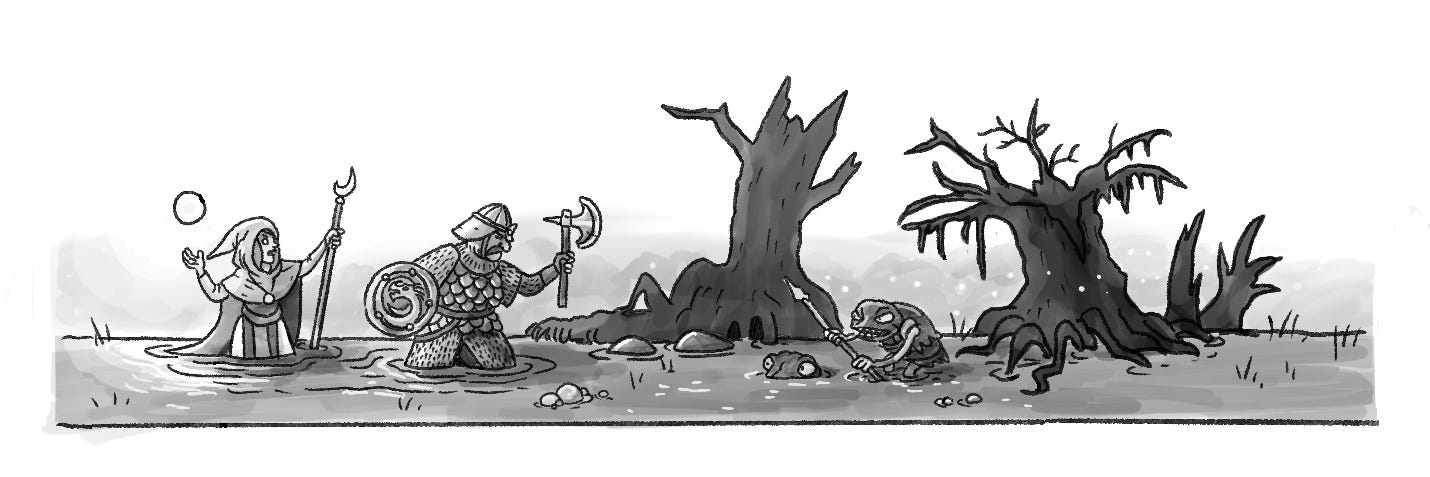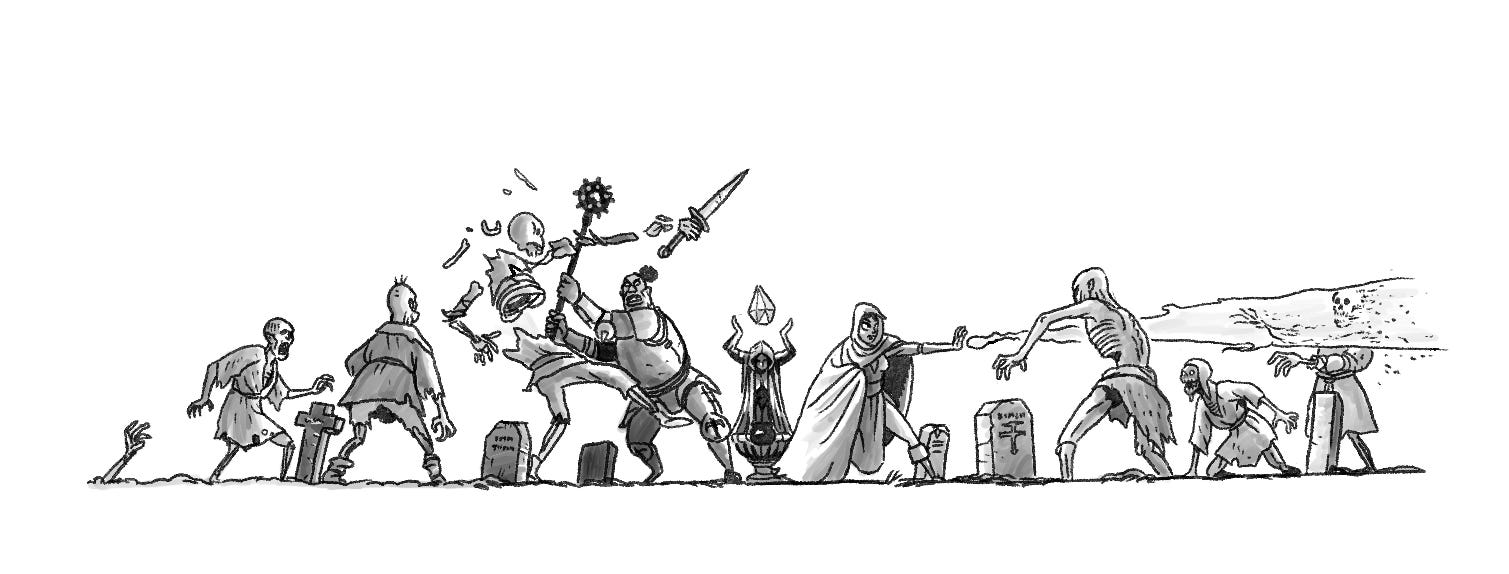I’ve been thinking about dungeons lately.
As we near the five-year anniversary (!!!!) of Dungeoneering’s launch on Kickstarter, I’ve been thinking a lot about where that product line is headed. Looking through the book, I see all the little imperfections that Today’s Nate wouldn’t make. The weird rules that feel a bit forced. The arcade-y style of the game’s mechanics.
Like I said, I’ve been thinking about dungeons.
Specifically, mechanics revolving around dungeon play, and some of the changes I’ve been thinking about making to any sort of 2nd Edition for my quick-and-dirty dungeon crawler.
I have no idea if these will turn into actual mechanics for an actual new edition.
Don’t hold me to it.
But, maybe… 😳
In the meantime, you have to read about dungeons for the next few weeks. Sorry, not sorry. In this article, I’m introducing the Omen Die and Finding the Dungeon.
Next week we’ll talk about something else. Until there’s nothing else to really be said. Feel free to steal these, tweak / remix them, and use them in your games — after all, that’s what I did.
Omen Die
DESIGN NOTE: One thing I don’t like about dungeon exploration procedures is that they feel pretty swingy a lot of the time. Even though you have equal chance to hit all entries on a d6 table, you will have games where you roll “Nothing” three times in a row. Or worse, 5 encounters in a row. Dice chains and a dynamic table change that.
Timekeeping: Dungeon Turns (10 min)
As more time passes, stranger events unfold. Danger lurks around every corner, waiting for the party to slip.
The OMEN DIE is the tool through which the GM tracks risk for the party. It begins as a d4, but rises through the dice chain to d6→d8→d10→d12→d20.
After each DUNGEON TURN, the GM rolls the omen die and compares it to the OMENS TABLE below:
1: Silence. Must have been the wind. The omen die moves once up the chain (e.g, d4→d6).
2: Delay. Something keeps you down. Roll the omen die twice at the end of the next dungeon turn and take both results.
3: Consume. Time to eat and drink. Rations and water levels decrease by 1.
4: Change. Dungeon denizens move. Patrols advance. Roll the next omen die twice and keep the highest.
5: Omen. A clue to something worth investigating or a danger worth avoiding. Roll 2d6. At the end of the next dungeon turn, the party chooses one of the two to apply. The unused result must be applied to the dungeon turn that follows.
6+: Encounter. You run into someone or something. The omen die moves once down the chain (eg, d6→d4).
As the omen die moves past a d6, the odds of rolling an encounter increase dramatically. If a die roll would result in two or more of the same omens, combine them into one.
Finding the Dungeon
DESIGN NOTE: Because my game is explicitly about dungeon-crawling, I’ve completely extracted finding the dungeon from other exploration or wilderness procedures. That said, because my game is about dungeon-crawling, there should be a procedure for finding the entrance to the dang thing.
Timekeeping: Dungeon Turns (10 min)
Unless directions have been given, you will have to find the entrance to the dungeon. Chances are it’s overgrown, sunken, buried, or built over.
Depending on how obscure the dungeon’s entrance is, the GM sets a DIFFICULTY SCORE (1-6) to determine how hard it is to find (where a 1 is no challenge and a 6 is nearly impossible).
Obvious (Difficulty 1-2, Navigator rolls 2d6, keeps highest): A shattered spire in a clearing; glowing runes on a basalt door; locals speak of “the hole in the hill.”
Partially-Obscured (Difficulty 3-4, Navigator rolls 1d6): Vines conceal an archway; one tower of the ruin still visible; reference only found on the oldest of maps.
Hidden (Difficulty 5-6, Navigator rolls 2d6, keeps lowest): Beneath the surface of a lake; under the false floor of a ruined shrine; a collapsed mine entrance 10 miles off-course.
The NAVIGATOR of the party makes a roll attempting to beat the difficulty score. A DUNGEON TURN passes for each attempt. The GM rolls the OMEN DIE.
A modifier of +1 is added to each subsequent roll and any circumstance that would assist in finding the dungeon (a map, a guide, tracks from previous dungeoneers, etc.)
Play Example
Let’s see how this all fits together:
GM: Okay — the Temple of Revuln is Hidden, as it was buried in the totally-natural-rockslide a few centuries ago in the High Torn Mountains, so, I’m setting it as a Difficulty 5. Emory, since you're navigating, you’ll roll 2d6, keep the lowest. You do have that old trade map from Galdrow's tower, so that's +1. Renly or Orin, anything to add?
Renly and Orin: No. Unfortunately.
GM: Each search takes a dungeon turn. Omen Die starts at d4.
Emory: Let’s go slow and careful.
Orin: As opposed to loud and annoying.
Renly: *laughing* Wait, we’re not supposed to be loud and annoying??
GM: *chuckles* Great, slow and steady. Roll it, Emory.
Emory: (Rolls 2d6) 3 and 5. Keeping the 3… plus 1 = 4. Damn.
GM: Not quite. You find some rusted mining carts at the edge of the tree line. No entrance yet — but you’re close. (Rolls Omen Die) Looks like a 1. The woods are silent. Just birdsong and shifting leaves. Omen Die ticks up — now it’s a d6.
Renly: Ugh… great.
GM: *smiles in GM* Again, please.
Emory: Yeah, rolling… (Rolls 2d6) 2 and 6. Keep the 2, +2 now = 4. Still no good.
GM: You find a sealed shaft buried in roots. Nothing moves. Just cold air leaking out. (Rolls Omen Die → 2) 2, a delay. Something slows you — maybe a rockslide, or bad footing. Next turn takes twice as long. And after that turn, I roll the Omen Die twice, and both effects apply.
Renly: Great. We're moving slower and louder.
Emory: Okay. Next roll… 1 and 5. Keep 1, +3 = 4. Jesus Christ.
Orin: Come onnnn.
GM: You uncover a sunken pulley system — buried under brush. Bones nearby, half-crushed. You’re definitely in the right place. (Rolls Omen Die twice → 3 and 5).
GM: Okay, first, a 3; that’s a Drain. Everyone mark off 1 ration and 1 water. You’re tired from all the hiking around these hills. Next, a 5, Omen. You spot a strange sigil etched into a jagged, jutting rock. Rolling… (Rolls 2d6 for Omen) Looks like I’m setting aside two dice: 4 and 6. One will apply at the end of the next turn. The other, right after that. Which do you want to apply first?
Orin: Let’s just get the encounter over with.
Renly: Maybe we do the 4 and their numbers will be decreased? 4 is when they all move and patrols change right?
GM: Yep.
Emory: I’m with Renly, I don’t want to risk an encounter before we even find the fucking door.
Renly and Orin: *nodding*
GM: Okay. So, go ahead and roll to see if we find the entrance.
Emory: 2 and 4. Keep the 2, +4 = 6. Jesus CHRIST.
Renly: Fucking finally!
Orin: *not paying attention, just got a notification that Mythic Bastionland just shipped; mutters “Hell yeah” to themselves*
GM: You find it. A sinkhole beneath an uprooted tree. At the bottom: a stone door, caked in mud and copper dust. The air shifts. Now — from those two Omen results. You wanted the 4, right?
Renly: Yes, 4.
Orin: I thought we said 6?
Emory and Renly: We literally all agreed 4.
GM: You nodded at 4. We can back up and talk about it if you want?
Emory: *sighs*
Orin: *smiles* Nah, all good - I’m fine with 4.
GM: Cool. Patrols have shifted. Something deeper in the dungeon has begun to move. And with the 6 you’re getting next turn — an Encounter — I think that something is moving to you.
Party: *groans*
GM: Oh come on, the Omen Die drops back to d4. It’ll be fiiiiine. Now, what do you want to do next?🟦
This article is brought to you by the following paid subscribers who make this newsletter possible:
Azzlegog (Founder)
Colin
DSPaul
Greg
Jan (Founder)
Michael
Mori (Founder)
Reed
Steve
Trevor










Love this. Simple and effective. I think Mythic Bastianland is going to get it's fingerprints on a lot of upcoming games ;)
Have you payed any depth delves like Stygian Library, or Gardens of Yinn?
If you haven't, their depth roll is worth checking out. Essentially you add the depth to the roll to see what you encounter, with more dangerous results further down the table. It means making some beefy tables but, you can control the pacing of threats quite nicely, while maintaining organic randomness.
For me, they're nice because they takes a little pressure off the GM to come up with something new at the table every time you get the same roll because you get to preload some creativity into the roll table.
Elegant! Absolutely adore finding the dungeon. So much juicier than "you get there," while also providing some simple yet interesting groundwork for the between-wilderness-and-dungeon encounter area.